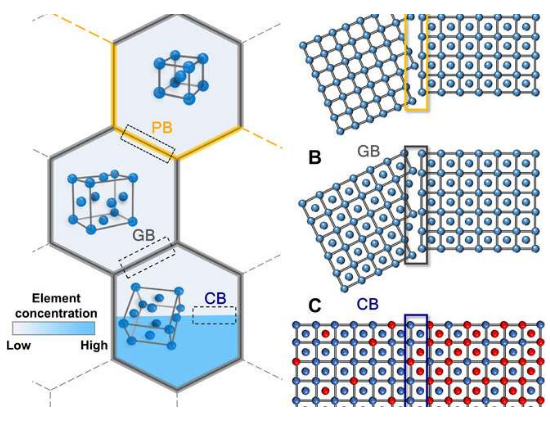博文
化学边界工程技术的应用
|||
化学边界工程技术的应用
——创建强度高且柔韧性高,碳含量低的钢
诸平
据《科学进展》(Science Advances)2020年3月27日发表的来自中国、德国、日本和荷兰的一组研究人员的最新成果,他们找到了一种方法,可以使用化学边界工程(chemical boundary engineering)技术来制造强度高且柔韧性高的钢材,而无需高碳含量。

Fig. 1 Schematic illustration of a PB, a GB, and a CB.
PB (phase boundary), a boundary between two grains of different lattice type. (B) GB(grain boundary), a boundary between two grains of the same lattice type but with different crystallographic orientations. (C) CB (chemical boundary), defined by a sharp discontinuity of at least one elemental concentration inside a lattice-continuous region, e.g., a very sharp chemical gradient. Note that our CBs(chemical boundaries) do not involve any change in crystal structure or lattice orientation. The different colors represent atoms of different element type.
图1是来自上述多国科学家合作研究论文的PB,GB和CB的示意图。(A)相边界(phase boundary, PB)即不同晶格类型的两个晶粒之间的边界。(B)晶粒边界(grain boundary, GB)即相同晶格类型但具有不同晶体学取向的两个晶粒之间的边界。(C)化学边界(chemical boundary, CB)即由晶格连续区域内至少一种元素浓度的明显不连续,也就是存在非常尖锐的化学梯度。请注意,我们的化学边界(CB)不涉及晶体结构或晶格取向的任何变化。图1中不同的颜色表示不同元素类型的原子。
在发表于《科学进展》(Science Advances)杂志上的论文中,该小组描述了他们的技术及其在测试中的效果。详见Ran Ding, Yingjie Yao, Binhan Sun, Geng Liu, Jianguo He, Tong Li, Xinhao Wan, Zongbiao Dai, Dirk Ponge, Dierk Raabe, Chi Zhang, Andy Godfrey, Goro Miyamoto, Tadashi Furuhara, Zhigang Yang, Sybrand van der Zwaag, Hao Chen. Chemical boundary engineering: A new route toward lean, ultrastrong yet ductile steels. Science Advances, 27 Mar 2020: Vol. 6, no. 13, eaay1430. DOI: 10.1126/sciadv.aay1430
参与此项研究的有来自清华大学的中国科学家,还有来自德国马克斯·普朗克研究所(Max-Planck-Institut für Eisenforschung)以及Institute for Materials & ZGH;日本东北大学(Tohoku University)和荷兰德尔福特理工大学(Delft University of Technology)的科学家。研究人员指出,他们的工作基于对用于交通运输和其他基础设施项目的轻质高强度钢的需求。他们进一步指出,大多数高强度钢,特别是具有极限拉伸强度的钢,都需要高含量的碳或其他昂贵的元素。在这项新的尝试中,研究人员证明了化学边界工程技术可用于制造高强度钢,而无需添加碳或其他元素。
化学边界工程是一种技术,通过该技术,材料(如钢)的微观结构中的微小缺陷会导致产生尖锐的化学梯度。当与钢一起使用时,结果是马氏体和奥氏体的晶粒交替出现,这使钢比其他轻。先前的研究表明,在钢中产生微小的缺陷可用于生产较便宜的强韧钢,但这样做往往会导致其在承受应变或热的情况下损坏。为了解决使用化学边界工程技术的先前问题,研究人员使用了一种技术,该技术在奥氏体晶粒域与少量锰交替的位置之间生成化学边界。其过程涉及冷轧低碳钢,然后使其经受标准奥氏体反转处理2 h。然后将钢加热到单相奥氏体区域并冷却到环境温度。在冷却阶段,金属沉降到不同的阶段,直到达到其最终状态。该团队通过使用化学品创建样品来测试他们的技术边界工程和其他使用标准技术的工程。他们发现,与标准方法相比,他们的新技术使钢材更坚固,而没有任何挠性损失。他们还发现测试表明,使用新技术生产的钢的强度等级超过2.0 GPa。更多信息请注意浏览原文或者相关报道。
New way to make steel that is both stronger and more ductile
Abstract
For decades, grain boundary engineering has proven to be one of the most effective approaches for tailoring the mechanical properties of metallic materials, although there are limits to the fineness and types of microstructures achievable, due to the rapid increase in grain size once being exposed to thermal loads (low thermal stability of crystallographic boundaries). Here, we deploy a unique chemical boundary engineering (CBE) approach, augmenting the variety in available alloy design strategies, which enables us to create a material with an ultrafine hierarchically heterogeneous microstructure even after heating to high temperatures. When applied to plain steels with carbon content of only up to 0.2 weight %, this approach yields ultimate strength levels beyond 2.0 GPa in combination with good ductility (>20%). Although demonstrated here for plain carbon steels, the CBE design approach is, in principle, applicable also to other alloys.
https://blog.sciencenet.cn/blog-212210-1226373.html
上一篇:科学网博客累计访问总量Top20分析
下一篇:新测量显示出在二碲化铀超导体中难以捉摸粒子的证据